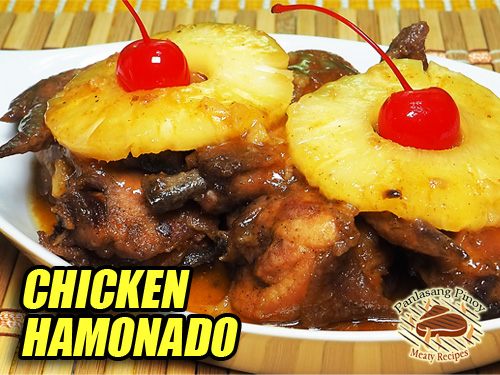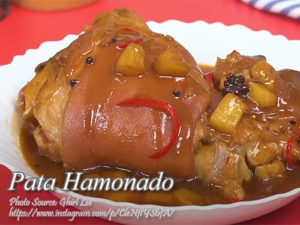This chicken hamonado is a quick and easy to cook version that does not require to marinate the chicken in pineapple juice and sugar mixture. Instead, you just fry or braise the chicken first then cook it in pineapple juice and pineapple slices. This version is best if you are in a hurry to cook hamonado. Try it I’m sure you will love it!
Chicken Hamonado: A Dish That Tastes Like Home
If there’s one dish that never fails to bring me back to cherished family gatherings, it’s chicken hamonado. There’s something deeply comforting about that perfect balance of sweet and savory flavors, a taste that reminds me of weekend meals in my grandmother’s kitchen in Quezon province. The aroma of pineapple and simmering chicken would fill the air, mingling with the laughter and stories that drifted through the open windows. Even if you didn’t grow up with these memories, hamonadong manok has a way of wrapping you in its warm, nostalgic embrace.
A Simple Yet Flavorful Shortcut
My version of chicken hamonado is inspired by those family meals but simplified for busy days. This recipe doesn’t require hours of marinating, making it perfect when you’re in a hurry yet craving something special. I’ll never forget when my cousin, Tito Alex, who is always looking for ways to cut cooking time without sacrificing flavor, shared this method with me. It’s become my go-to ever since, especially on nights when I want a taste of home but need to whip up dinner quickly.
Instead of soaking the chicken in pineapple juice and sugar overnight, this version makes use of a shorter marination and a flavorful braising process. And trust me, even without a long soak, the tender chicken soaks up all the sweet, tangy goodness of the sauce, which comes together beautifully as it cooks.
Starting Chicken Hamonado with a Simple Marinade
Every great dish begins with building layers of flavor, and chicken hamonado is no exception. In this recipe, the chicken is briefly marinated with patis (fish sauce), cracked black pepper, granulated seasoning, and a touch of kalamansi juice. Kalamsi adds a hint of brightness that cuts through the richness of the chicken, and I remember my Lola always saying that a good splash of citrus can make a world of difference. The acidity starts to tenderize the meat while infusing it with a subtle tang.
Letting the chicken marinate for at least 30 minutes is key. It’s a short step but incredibly important. If you have more time, feel free to let it soak a little longer, but 30 minutes is all you really need. As my mom would say, “Patience with good seasoning is never wasted.”
Frying for a Golden Finish
The next step is frying the chicken until it’s golden brown. This step adds a rich, caramelized crust to the meat, which not only locks in the juices but also deepens the flavor of the final dish. When my younger sister Lani first learned to cook, she’d skip this step, and we’d end up with a less vibrant hamonado. After some teasing from our cousins and a few burnt attempts, she realized that searing the chicken was non-negotiable.
Why does this work so well? The Maillard reaction, the same process that gives seared steak or toasted bread its depth of flavor, enhances the chicken, making every bite more satisfying. This golden crust also helps the chicken hold its shape better as it simmers, so you won’t end up with shredded pieces.
Building the Sauce for Chicken Hamonado
Now, onto the heart of the dish: the sauce. With the excess oil removed from the pan, you’re left with the browned bits and a touch of oil, perfect for sautéing garlic. This simple but fragrant base is like a warm embrace, and once you add the chicken back in and pour the pineapple juice over it, the magic begins.
The sugar and salt bring the right balance to the sauce. I recall one summer when my Kuya Ben, who’s always experimenting in the kitchen, tried using honey instead of sugar. While it added a unique twist, we all agreed that good old white sugar gives the best caramelization and a clean sweetness. The sauce needs to simmer for around 30 minutes, thickening slowly while the flavors meld together.
The Pineapple Finale
Finally, sliced pineapples and their juice join the pot, adding bursts of fruitiness that complement the savory, umami notes of the chicken. In traditional hamonado, the sweetness of pineapple mimics the glaze on Christmas ham, which is where the dish gets its name. It’s this beautiful fusion of Spanish influence and native ingredients that gives Filipino cuisine its signature charm.
My favorite memory of this step comes from when my cousin Pia and I would sneak slices of pineapple from the can while we waited. Pineapple adds more than just sweetness; its enzymes tenderize the chicken, making every bite melt-in-your-mouth delicious. Be sure to cook the sauce until it’s thick and glossy, coating each piece of chicken perfectly.
A Taste of Home
Once you turn off the heat, serve your chicken hamonado hot over steamed rice. Let the sauce soak into the grains and enjoy how the flavors wrap around each bite. Even on the busiest of days, a plate of this dish brings me back to those warm, laughter-filled afternoons in our family home.
Food for thought: Chicken hamonado is more than just a quick weeknight meal; it’s a delicious reminder of how Filipino cuisine masterfully balances the sweet, the savory, and the soulful. Whether you’re cooking it for the first time or revisiting an old favorite, I hope it brings as much joy to your table as it has to mine.
How To Cook Chicken Hamonado
Ingredients
- 1 kilo chicken cut into serving pieces
- 1 Tbsp. patis
- 1/2 tsp. black pepper powder
- 1 Tbsp. kalamansi juice or lemon juice
- 1 tsp. Magic sarap or Namnam
- 4 cloves garlic minced
- 1/3 cup sugar
- 1 & 1/2 cup pineapple juice
- 1 small can pineapple slice
- cooking oil for frying
Instructions
How To Cook Chicken Hamonado
- Combine chicken, patis, black pepper, granulated seasoning and kalamansi juice in a bowl. Mix the ingredients until well coated then marinate for 30 minutes.
- Heat cooking oil in a pan about 1 inch deep and fry the chicken until golden brown. Strain to remove excess oil and set aside.
- In the same pan, remove the cooking oil and leave about 1 Tbsp. in the pan. Herat the oil and saute garlic until fragrant.
- Add the chicken and saute for a minute. Pour the pineapple juice and add sugar and salt. Stir and bring the liquid into a boil.
- Simmer for 30 minutes until slightly thick. Add in the sliced pineapples and pour also the liquid from the canned sliced pineapples.
- Continue cooking until the sauce is thick. Turn off heat and serve hot. Enjoy!
Video
Notes
Cooking Tips:
Marinate for Maximum Flavor
While this quick version of chicken hamonado doesn't require overnight marination, giving the chicken at least 30 minutes to soak up the patis, black pepper, and kalamansi juice makes a big difference. The acid in the kalamansi tenderizes the chicken and infuses it with a bright, tangy flavor that balances the sweet sauce. If you have extra time, extending the marination up to an hour can make the dish even more flavorful.Sear the Chicken for Depth
Frying the chicken until golden brown before simmering helps develop a deep, caramelized flavor that enhances the final dish. The Maillard reaction that occurs during searing not only locks in the juices but also adds a rich, savory layer to the sauce. Make sure the oil is hot enough so the chicken crisps up quickly without absorbing excess oil.Cook the Sauce Until Thick and Glossy
Simmering the pineapple juice with sugar and salt until it thickens ensures the sauce coats the chicken beautifully, giving it a glossy, appetizing finish. Be patient and let the sauce reduce slowly; rushing this step can leave you with a watery sauce that doesn't cling to the meat. The addition of pineapple slices at the end not only adds texture but also brings a burst of fruity sweetness that complements the savory notes perfectly.





